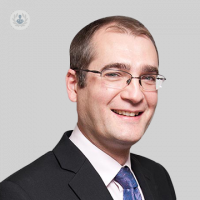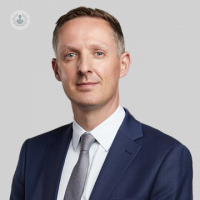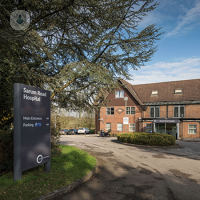Non-surgical treatment of varicose veins
Mr Martin Claridge - Vascular surgery
Created on: 11-22-2013
Updated on: 04-17-2023
Edited by: Aoife Maguire
What are varicose veins?
Varicose veins are twisted, enlarged veins that are visible below the surface of the skin. They tend to be blue or purple in colour and usually develop on the legs. Varicose veins may not be serious but they can cause aching, pain, itching and restlessness in the affected leg and their appearance can be unsightly. In some cases skin changes can occur (haemosiderin deposits, lipodermatosclerosis and venous eczema) which can be signs that a patient is much more likely to develop a leg ulcer. Very rarely varicose veins can cause significant bleeding.

How are varicose veins treated?
Traditionally, varicose veins were removed using an invasive procedure known as ‘vein stripping’ but nowadays, non-invasive or minimally invasive techniques are preferred as they offer improved results and greater safety. Non-surgical, minimally invasive techniques use small incisions as opposed to open surgery and as such the risk of infection, bleeding or other complications is lower. Most treatments either use heat (endothermal ablation via a laser or radiofrequency catheter) or a chemical sclerosant to destroy the smooth fatty lining of the vein. The vein then blocks up and is absorbed by your body.
What are the non-surgical treatment options for varicose veins?
There are three principal types of non-surgical varicose vein treatment:
- sclerotherapy
- ablation
- microphlebectomy
Sclerotherapy is a technique using a chemical solution applied by injection to the vein. After being injected, the vein scars and hardens. Any blood that formerly passed through the vein will be rerouted and as a result, the enlarged vein will be reabsorbed by the body and will no longer be visible. This techniques works best on smaller veins, or spider veins.
Vein ablation is a technique that uses either radiofrequency or laser energy to transmit heat to the affected vein and is sometimes referred to as radiofrequency ablation or endovenous laser ablation. The intense heat applied directly to the vein via a catheter causes its walls to collapse and seal shut, meaning it will eventually be reabsorbed by the body.
Microphlebectomy, also known as ambulatory phlebectomy, is a technique where the vein is removed from the leg’s surface through a small incision using a light to guide the treatment.
In some cases, treatment may need to be repeated to obtain good results. The specialist vascular surgeon can advise individual patients on their optimal treatment plan.
Who is suitable for this type of treatment?
In some cases, varicose veins can be improved by making some lifestyle changes and the patient may not require any treatment. Varicose veins can be helped in the following ways:
- exercising regularly
- maintaining a healthy weight
- elevating the legs while seated
- wearing compression stockings
- avoiding sitting or standing still for long periods of time
If these lifestyle changes are not effective and the patient's confidence is affected by their physical appearance, non-invasive treatment for varicose veins may be considered. Additionally, any patients experiencing pain or cramping in the area or the formation of ulcers or sores will be recommended for further treatment by a professional.
In some patients, varicose veins lead to further complications and the necessity of treatment. These complications can include lipodermasclerosis, a hardening of fatty tissue under the skin caused by the increased blood pressure of varicose veins, and phlebitis, an inflammation of the vein.
Are these types of procedures safe?
Non-invasive or minimally invasive procedures have far fewer risks than open surgical procedures as well as shorter recovery periods.
However, as with any medical procedure, there is a small chance of general further complications, including bleeding, scarring, infection and blood clots. Each non-surgical technique carries some risks which are specific to the treatment. These occur in very rare cases and can be thoroughly discussed with the healthcare provider before undergoing treatment.
What type of doctor performs non-surgical treatment of varicose veins?
Specialist vascular surgeons and dermatologists perform non-surgical treatment of varicose veins. The only specialists in the UK with National Accreditaion to treat varicose veins are vascular surgeons.






